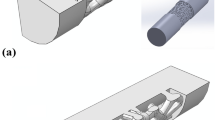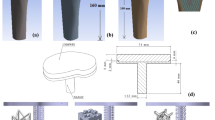Abstract
Porous titanium based implants have found various use in dental implants, tissue and bone regeneration. In the present paper, a method of generating models of porous titanium material has been developed from micro-computed tomography radiograph images. Images are processed and three solid models are generated for analysis. To observe the stress contour and the failure initiation at micro level, a method of submodeling has been employed to investigate the effect of loading on the micro-computed tomography based models kept at the centre of a global model of near equivalent porosity. Equivalent, shear and normal stress profiles on the generated model have been analysed to quantify the variation of stress-strain nature and to predict the nature of failure at the micro-porous localized regions due to cyclic nature of loading. Additionally, the average wall shear stress of one of the scaffolds has been determined using Computational Fluid Dynamics analysis at three different inlet velocities.








Similar content being viewed by others
References
S.J. Simske, R.A. Ayers and T.A. Bateman, Porous Materials for Bone Engineering, Mater. Sci. Forum., 1997, 250, p 151–182.
J. Banhart, Manufacture, Characterisation and Application of Cellular Metals and Metal Foams, Prog. Mater Sci., 2001, 46(6), p 559–632.
R.G. Geesink, K. de Groot and C.P. Klein, Bonding of Bone to Apatite-Coated Implants, J Bone Joint Surg. Br. Vol., 1988, 70(1), p 17–22.
A. Pal, P. Nasker, S. Paul, A.R. Chowdhury, A. Sinha and M. Das, Strontium Doped Hydroxyapatite from Mercenaria Clam Shells: Synthesis, Mechanical and Bioactivity Study, J. Mech. Behav. Biomed. Mater., 2019, 1(90), p 328–336.
R. Oriňaková, R. Gorejová, Z. Orságová Králová and A. Oriňak, Surface Modifications of Biodegradable Metallic Foams for Medical Applications, Coatings, 2020, 10(9), p 819.
K. Pałka, G. Adamek and J. Jakubowicz, Compression Behavior of Ti Foams with Spherical and Polyhedral Pores, Adv. Eng. Mater., 2016, 18(8), p 1511–1518.
C.E. Wen, Y. Yamada, K. Shimojima, Y. Chino, T. Asahina and M. Mabuchi, Processing and Mechanical Properties of Autogenous Titanium Implant Materials, J. Mater. Sci. - Mater. Med., 2002, 13(4), p 397–401.
M. Takemoto, S. Fujibayashi, M. Neo, J. Suzuki, T. Kokubo and T. Nakamura, Mechanical Properties and Osteoconductivity of Porous Bioactive Titanium, Biomaterials, 2005, 26(30), p 6014–6023.
S.J. Hollister, Scaffold Design and Manufacturing: From Concept to Clinic, Adv. Mater., 2009, 21(32–33), p 3330–3342.
M. Rana, S.K. Karmakar, B. Pal, P. Datta, A. Roychowdhury and A. Bandyopadhyay, Design and Manufacturing of Biomimetic Porous Metal Implants, J. Mater. Res., 2021, 36(19), p 3952–3962.
M. Rana, A. Chaudhuri, J.K. Biswas, S.I. Karim, P. Datta, S.K. Karmakar and A. Roychowdhury, Design of Patient Specific Bone Stiffness Mimicking Scaffold, Proc. Inst. Mech. Eng. [H], 2021, 235(12), p 1453–1462.
L. Gibson and Ashby, in Cellular Solids: Structure and Properties (Cambridge Solid State Science Series, 1999), pp. 175–234.
S. Roy, N. Khutia, D. Das, M. Das, V.K. Balla, A. Bandyopadhyay and A.R. Chowdhury, Understanding Compressive Deformation Behavior of Porous Ti Using Finite Element Analysis, Mater. Sci. Eng. C, 2016, 1(64), p 436–443.
A. Chakraborty, P. Datta, S. Majumder, S.C. Mondal and A. Roychowdhury, Finite Element and Experimental Analysis to Select Patient’s Bone Condition Specific Porous Dental Implant, Fabricated Using Additive Manufacturing, Comput. Biol. Med., 2020, 124, p 103839.
C. Torres-Sanchez, F.R. Al Mushref, M. Norrito, K. Yendall, Y. Liu and P.P. Conway, The Effect of Pore Size and Porosity on Mechanical Properties and Biological Response of Porous Titanium Scaffolds, Mater. Sci. Eng. C., 2017, 77, p 219–228.
I. Duarte, T. Fiedler, L. Krstulović-Opara and M. Vesenjak, Brief Review on Experimental and Computational Techniques for Characterization of Cellular Metals, Metals., 2020, 10(6), p 726.
I. Vasconcelos, M. Franco, M. Pereira, I. Duarte, A. Ginjeira and N. Alves, 3D-Printed Multisampling Holder for Microcomputed Tomography Applied to Life and Materials Science Research, Micron, 2021, 1(150), p 103142.
N. Tsafnat, N. Amanat and A.S. Jones, Analysis of Coke Under Compressive Loading: A Combined Approach Using Micro-computed Tomography, Finite Element Analysis, and Empirical Models of Porous Structures, Fuel, 2011, 90(1), p 384–388.
R. Singh, P.D. Lee, T.C. Lindley, C. Kohlhauser, C. Hellmich, M. Bram, T. Imwinkelried and R.J. Dashwood, Characterization of the Deformation Behavior of Intermediate Porosity Interconnected Ti Foams Using Micro-Computed Tomography and Direct Finite Element Modeling, Acta Biomater., 2010, 6(6), p 2342–2351.
T. Wejrzanowski, S.H. Ibrahim, J. Skibinski, K. Cwieka and K.J. Kurzydlowski, Appropriate Models for Simulating Open-Porous Materials, Image Anal. Stereol., 2017, 36(2), p 105–110.
D. Heitor, I. Duarte and J. Dias-de-Oliveira, Aluminium Alloy Foam Modelling and Prediction of Elastic Properties Using x-ray Microcomputed Tomography, Metals., 2021, 11(6), p 925.
D. Ali and S. Sen, Permeability and Fluid Flow-Induced Wall Shear Stress of Bone Tissue Scaffolds: Computational Fluid Dynamic Analysis Using Newtonian and Non-Newtonian Blood Flow Models, Comput. Biol. Med., 2018, 1(99), p 201–208.
B. Liu and D. Tang, Influence of Non-Newtonian Properties of Blood on the Wall Shear Stress in Human Atherosclerotic Right Coronary Arteries, Mol. Cell. Biomech. MCB., 2011, 8(1), p 73.
F. Zhao, T.J. Vaughan and L.M. McNamara, Quantification of Fluid Shear Stress in Bone Tissue Engineering Scaffolds with Spherical and Cubical Pore Architectures, Biomech. Model. Mechanobiol., 2016, 15(3), p 561–577.
B.P. Mahammod, E. Barua, P. Deb, A.B. Deoghare and K.M. Pandey, Investigation of Physico-mechanical Behavior, Permeability and Wall Shear Stress of Porous HA/PMMA Composite Bone Scaffold, Arab. J. Sci. Eng., 2020, 45(7), p 5505.
H. Bart-Smith, A.F. Bastawros, D.R. Mumm, A.G. Evans, D.J. Sypeck and H.N. Wadley, Compressive Deformation and Yielding Mechanisms in Cellular Al Alloys Determined Using X-ray Tomography and Surface Strain Mapping, MRS Online Proce Libr (OPL), 1998 https://doi.org/10.1557/PROC-521-71
J. Šleichrt, T. Fíla, P. Koudelka, M. Adorna, J. Falta, P. Zlámal, J. Glinz, M. Neuhäuserová, T. Doktor, A. Mauko and D. Kytýř, Dynamic Penetration of Cellular Solids: Experimental Investigation Using Hopkinson Bar and Computed Tomography, Mater. Sci. Eng. A., 2021, 7(800), p 140096.
C. Veyhl, I.V. Belova, G.E. Murch and T. Fiedler, Finite Element Analysis of the Mechanical Properties of Cellular Aluminium Based on Micro-Computed Tomography, Mater. Sci. Eng., A, 2011, 528(13–14), p 4550–4555.
L. Osagie-Clouard, J. Kaufmann, G. Blunn, M. Coathup, C. Pendegrass, R. Meeson, T. Briggs and M. Moazen, Biomechanics of Two External Fixator Devices Used in Rat Femoral Fractures, J. Orthop. Res., 2019, 37(2), p 293–8.
P. Vossenberg, G.A. Higuera, G. Van Straten, C.A. Van Blitterswijk and A.J. Van Boxtel, Darcian Permeability Constant as Indicator for Shear Stresses in Regular Scaffold Systems for Tissue Engineering, Biomech. Model. Mechanobiol., 2009, 8(6), p 499–507.
X. Xue, M.K. Patel, M. Kersaudy-Kerhoas, M.P. Desmulliez, C. Bailey and D. Topham, Analysis of Fluid Separation in Microfluidic T-Channels, Appl. Math. Model., 2012, 36(2), p 743–755.
I. Maskery, A.O. Aremu, L. Parry, R.D. Wildman, C.J. Tuck and I.A. Ashcroft, Effective Design and Simulation of Surface-Based Lattice Structures Featuring Volume Fraction and Cell Type Grading, Mater. Des., 2018, 5(155), p 220–232.
A. Du Plessis, I. Yadroitsava, I. Yadroitsev, S.G. Le Roux and D.C. Blaine, Numerical Comparison of Lattice Unit Cell Designs for Medical Implants by Additive Manufacturing, Virtual and Physical Prototyping., 2018, 13(4), p 266–281.
F.M. White, Fluid Mechanics, McGraw-Hill, New York, 2008.
D. Egger, M. Fischer, A. Clementi, V. Ribitsch, J. Hansmann and C. Kasper, Development and Characterization of a Parallelizable Perfusion Bioreactor for 3D Cell Culture, Bioengineering, 2017, 4(2), p 51.
J.W. Gooch Ed., Encyclopedic Dictionary of Polymers, Springer, Berlin, 2010
A. Lesman, Y. Blinder and S. Levenberg, Modeling of Flow-Induced Shear Stress Applied on 3D Cellular Scaffolds: Implications for Vascular Tissue Engineering, Biotechnol. Bioeng., 2010, 105(3), p 645–654.
A. Campos Marin and D. Lacroix, The Inter-sample Structural Variability of Regular Tissue-Engineered Scaffolds Significantly Affects the Micromechanical Local Cell Environment, Interface Focus., 2015, 5(2), p 20140097.
E.E. Aşik, B. Tunca, G.I. Nakaş and Ş Bor, Fatigue Behavior of 51 vol.% Porous Ti-6Al-4V Alloy, Mater. Sci. Forum, 2014, 783, p 1221–1225.
Author information
Authors and Affiliations
Corresponding author
Additional information
Publisher's Note
Springer Nature remains neutral with regard to jurisdictional claims in published maps and institutional affiliations.
Rights and permissions
About this article
Cite this article
Bhattacharyya, R., Rana, M., Gupta, A. et al. Modelling of Porous Titanium and Understanding Its Mechanical Behavior Using Micro-Computed Tomography. J. of Materi Eng and Perform 31, 8160–8168 (2022). https://doi.org/10.1007/s11665-022-06827-z
Received:
Revised:
Accepted:
Published:
Issue Date:
DOI: https://doi.org/10.1007/s11665-022-06827-z




